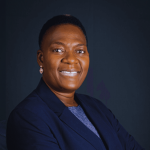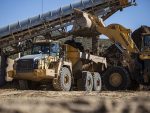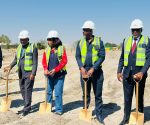Namibia Critical Metals told investors it has commenced the final phase of drilling for the pre-feasibility study (PFS) on its large-scale dysprosium-terbium Lofdal 2B-4 heavy rare earth project in Namibia.
The final drill phase, which entails seven very deep reverse circulation (RC) boreholes for a total of 2,505 meters in the Area 4 main deposit, is expected to be completed by early December 2023.
While the holes were originally planned as a separate diamond core (DC) drilling campaign, the company said it was able to save costs and time after RC infill drilling earlier this year produced qualitatively equal data.
The company explained that five boreholes represent infill boreholes in the deeper part of the central Area 4 deposit, while two of the boreholes aim at the same time at resource expansion at the newly established mineralized zone in the western part of the Area 4 deposit.
Describing the final phase of drilling as “a big step forward towards completion of the PFS,” Namibia Critical Metals president Darrin Campbell commented: “While infill drilling is rather a technical necessity, I’m thrilled to see what the two additional boreholes in the newly identified mineralized zone at western Area 4 will show.
“These holes have a realistic potential to further extend the Area 4 deposit. Beyond that remains a massive upside in growing the resource with future exploration outside Areas 2B and 4 which only represent a small fraction of the large-scale mineralized system on our Lofdal Mining License area,” he added.
Namibia Critical Metals is developing the Tier-1 Heavy Rare Earth Project, Lofdal, a globally significant deposit of the heavy rare earth metals dysprosium and terbium.
Demand for these critical metals used in permanent magnets for electric vehicles, wind turbines and other electronics is driven by innovations linked to energy and technology transformations. The geopolitical risks associated with sourcing many of these metals have become a repeated concern for manufacturers and end users. Namibia is a proven and stable mining jurisdiction.
China has had an overwhelming stranglehold on all facets of production and processing of rare earth oxides, but given fluctuations in the relationships of other G7 economies with the communist giant other sources of sustainable supply have been keenly sought, particularly by Japan which is actually the second largest consumer of rare earths outside of China
Namibia Critical Metals is aiming to become a long-term, sustainable supplier of heavy rare earths, and it is currently pursuing a pre-feasibility study (PFS) at Lofdal having started a final drill program at the end of January 2023 to increase the level of resource categories as required for the expanded project.
In an interview earlier this year, Darrin Campbell, Namibia Critical Metals president, said the company is focused on the project at Lofdal, which has the potential for significant production of dysprosium and terbium.
“Lofdal is located in central Namibia. We’ve been working on it since about 2011 and have now established it as being a globally significant deposit of the heavy rare earths, dysprosium and terbium, which are two of the critical metals used in the production of permanent magnets for EV motors, wind turbines, and other electronics. It is a very unique deposit, being one of only two xenotime-type deposits under development in the world that we’re aware of, the other being Northern Minerals’ Browns Range deposit in Australia.
“We put out our initial preliminary economic assessment (PEA) for Lofdal in 2014 and our first mineral resource in 2012, and a valid criticism against the project at that time was that it was just too small being only about a 6 million tonne resource with less than a seven-year mine life. However, with recent developments over the last two and a half years with our joint venture partners, we’ve completely dispelled those criticisms and have now established Lofdal as being one of the largest deposits of dysprosium and terbium anywhere in the world outside of China,” said.
He went on to state that in 2020, they entered into a transformational transaction, securing a joint venture with JOGMEC, the Japan organization for metals and energy security, a Japanese government state agency.
“They have a multi-billion-dollar budget and a mandate to secure supply of natural resources for Japanese industry. About a decade ago, or more, JOGMEC did a joint venture with a very little-known light rare earth explorer out of Australia called Linus, which they have funded for over US$300 million to date, making Linus now one of the largest rare earth companies in the world. That was to secure supply of light rare earths for Japan, and they have now turned their attention to our Lofdal deposit to be a long-term supplier of the heavy rare earths, in particularly dysprosium and terbium, for Japan for the next decade or longer. And that’s exactly what we’re on track to accomplish.
“The terms of our partnership with JOGMEC call for them to spend C$20 million in three different terms in order to earn a 50% interest and we just announced a few weeks ago that they will be completing term two of the three by next month. They have advanced additional funds to get them over the $10 million exploration requirement to reach their first 40% interest and we are now in the process of finalizing restructuring of our Namibian subsidiaries to accommodate their interest in the project going forward. We expect them to spend the final C$10 million for an additional 10% to get them the 50% agreed over the next two years.”










